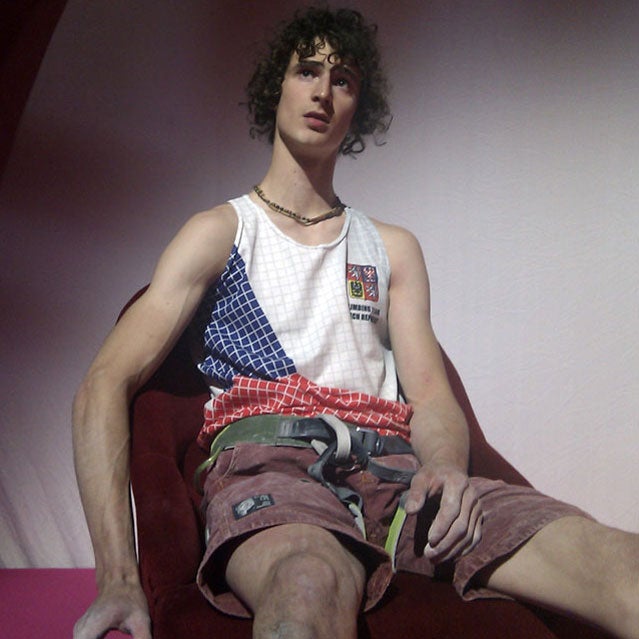After making the first ascent of Change, Adam Ondra was ready for one. The 19-year-old Czech climber had spent over a month in Norway’s massive Flatanger Cave working the 165-foot-long route—at 5.15c, the world’s hardest—before finally managing to climb it on October 2. With the toughest send of his life behind him, Ondra decided he needed a break from projecting. He had never been to the United States, so he booked a ticket to Kentucky and headed for the Red River Gorge, the legendary sandstone sport climbing area located along the river of the same name.
By the time Ondra left the Red a few weeks later, he had torn the place apart. His ticklist from the trip could easily double as a lifetime bucket list for most high-level pros: he had , including The Golden Ticket (5.14c/d) and Pure Imagination (5.14c/d), and had become the first person to climb a 5.14d first go with a flash of Southern Smoke Direct.
Ondra, a Brno native with a mane of curly hair, doesn’t get the level of recognition among non-climbers that Chris Sharma and Alex Honnold do. But if you wanted to name the best sport climber in the world, it would be hard to make an argument for anyone but him. A two-time World Cup champion with 20 5.15 ascents to his credit, Adam Ondra seems to operate on a different, grander scale than anyone else in the sport. We caught him after a three-hour gym session to talk about his new projects, the U.S. scene, and what he’s taken away from .
This was your first trip to the U.S. Why did you pick the Red River Gorge as your first destination?
I really liked the pictures I saw. It resembled a Czech climbing area that I liked, but with overhanging stuff. At the same time, I heard that there were plenty of high-quality climbs and that there was good potential for hard onsighting. After spending a lot of time working on my project in Norway, Change, I felt like I wanted to do a bit of onsighting.
Tell me a little about the highlights of your trip. What sends are you most proud of?
There are definitely two climbs. The first one is Southern Smoke Direct (5.14d/5.15a), which was rather strange for me, because it was something I was not really thinking about prior to my departure. I had it in my mind that it might have been possible to flash it but I did not really believe it so much, because I knew that the first boulder problem was really hard. The first four or five climbing days, I didn’t feel very strong. I was kind of thinking of postponing my goals for the next trip. But obviously, you can run out of good routes to onsight pretty soon.
This was kind of a strange day. I knew that Daniel Woods and Jon Cardwell went there, so I told myself, Why not try? This might be my only chance to flash this route. And that’s exactly what happened. Sometimes I wonder how it’s even possible that I can get so much luck in one single minute, but I think it’s better not to wonder about it too much.
Since I was confident that my shape was not that bad, in about two days time I went for Pure Imagination (5.14d), which was the main goal on the trip; it went for an onsight quite well. But then there was The Golden Ticket (5.14d), which was much harder for me. I had some information that it was not that easy to onsight, but I was lucky.
How does the climbing scene in the U.S. compare to the one you’re used to in Europe?
I think in general the American scene is much more focused on bouldering, where in Europe they’re more focused on sport climbing. But there’s no surprise there, because I think that in most parts of the U.S. you can get really high-quality bouldering areas, but it’s really hard to find high-quality sport-climbing areas. Except the Red, which is a world-class climbing area. I have never seen something like this in terms of climbing on sandstone. It’s definitely in my top three favorite climbing areas right now.
I understand you bolted a new route while you were at the Red.
I was very impressed by the , especially that in the main part there had only been two routes bolted, Pure Imagination and The Golden Ticket. But there were two center lines that appeared even more difficult and were virgin. So I started bolting the one more on the left, which looked more difficult. There are multiple 8B+ (V14) boulder problems tacked on top of each other, with a maybe 8c (5.14b) topout. That is definitely something that is out of my abilities for right now, but it can be [within my abilities] in a couple of years.
Then, as I had only two days left, I started bolting the line to the right at the Chocolate Factory. It seemed a fair bit easier to me at the beginning, but as I started bolting and rappelling down, I found that at about one-third of the way up there is a heinous boulder problem which is going to be really hard. I don’t know, it could be something between 9a+ and 9c (5.15a-5.15d). I didn’t even have time to figure out the sequence, I just finished bolting and headed straight to the airport.
Do you think there’s potential for more cutting-edge sport routes like that in the Red?
Yes, there are definitely tons. You know, I only bolted two lines in an already-established sector, but I’m sure that there are still so many more walls to be bolted. There are obviously some access issues, but some of them could be solved. It’s an area with some of the most potential I’ve ever seen. Just endless.
As you mentioned, you recently did a new route, Change (5.15c), at Flatanger Cave in Norway. Tell me a little bit about the history of that route and how you came to try it.
I came to Flatanger with a plan in my mind to bolt a really, really hard thing that would be beautiful and keep me motivated to try it for a long time, in some underdeveloped area. Flatanger seemed like an obvious choice. Change, the line which I chose, seemed to me like the most secure choice in terms of having a route that would be really difficult, but at the same time not impossible. After bolting it for two days, I knew that the route was possible and immediately started working on it.
The process was really difficult. I was working on it throughout five weeks. The day before I sent it, I was not really confident. But somehow, the day was just perfect.
You’ve suggested that this could be the world’s hardest sport route. Just mentally speaking, how do you approach a route like that? Is it a struggle?
When I work on a route, I usually reach a certain state of mind when I know that it’s possible, but from this point it can last one day, or it can last three weeks, or it can last years until the point where I send it. This process of waiting for the day when everything clicks, when you are perfectly rested and perfectly motivated, is really frustrating. While working on Change, these mental difficulties were the toughest I’ve ever experienced.
A lot of people have given you the title “world’s best climber.” How do you feel about that?
For me, just to keep my motivation high and my passion high, I’m not even trying to think about it. When I take a look at this statement, I can admit that there are some reasons it could be true. But at the same time, you can’t really compare rock climbing. For me, it’s really important that I progressed and pushed my limits even further. If I took a look at it from the outside view, that I climbed the hardest route, there would be no more motivation for me to train hard and to keep progressing.
I just saw . You’ve been climbing with him for a while, at least a few years. What have you taken away from that?
Chris inspired me with his approach to opening new routes. It’s inspiring for me to take a look at him and to see his motivation to open a new line that seems absolutely ridiculous, always trying to find something really beautiful, but not hesitating to go for it and bolt it. Sometimes you find something that is impossible, but sometimes you find something that is just so beautiful and so motivating. At the same time, he’s a really nice guy to hang out with, and we had a lot of fun in Oliana.
There’s a lot of talk around climbing possibly being a new sport in the next summer Olympics. Would you compete?
I think climbing deserves to be an Olympic sport, as it is one of the few natural movements—like swimming or running, things that people have been doing for a thousand years. All of these natural movement sports are part of the Olympics, except for climbing. It’s nice that it’s not difficult to understand for normal people
At the same time, I don’t think climbing being in the Olympics would influence outdoor climbing. But there are so many ways to climb—you can do bouldering, you can do trad, you can do sport climbing, you can go into the mountains—and there are still so many routes where you can go and climb in solitude, that even if climbing became a little bit more famous, it wouldn’t be such a big deal. Even in places with a long tradition of climbing, like in the Alps, there are still so many virgin cliffs.
Climbing in the Olympics would be my dream, but I’m not so optimistic that it will make it in 2020. But there is still some hope, so we’ll see.


